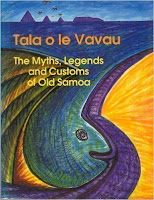Today, we arrive to our last stop in Australia and Oceania: Australia itself! Which means, this is also our last stop in the first complete continent of the journey! Thank you for sticking with me so far; it has been a lot of fun!
The opal that turned into fire
And other stories from the Wangkumara
Janet Mathews
Magabala, 1994.
Originally I picked this book because of the alluring title (I like shiny things), but it proved to be a great choice. Apart from the author's own collection of folklore, it also contains tales and beliefs from her grandfather-in-law, who traveled the southeast part of the continent in the 19th century, and noted many things that since have been forgotten. All the stories in the book come with notes, sources, and explanations; I only wished we would have found out more about the storytellers and their tribes (we did get a short biography of the collector). Another thing that I missed was a more detailed map and more visuals - many of the legends were so intricately tied to the landscape that it was hard to really appreciate them without seeing what they talked about. Still, the book was a fascinating read, full of vivid visual imagery.
Highlights
The book opens with creation myths and origin legends - some of them old enough to remember the time when the ocean levels rose and cut Australia off from Southeast Asia (about 6000-8000 years ago). One of the best one told the story of how the animals - led by Koala - paddled over to Australia in a canoe that they stole from Whale while Starfish distracted him (for which Whale later flattened the poor thing).
 |
| Sandpiper (picture from here) |
Animals, of course, were not the only creatures that appeared in the stories. There was, for example, a great travel-tale about a hero who crossed the lands of many strange beings - giant mosquitoes, people with emo legs (who were intrigued by human legs), and even people who had bushes growing on their back.
There was also a collection of legends about the "Hairy People", who seemed to be common in the lore of many tribes (in various sizes from tiny to gigantic, and various dispositions from man-eating to vegan). These were especially interesting to read since the Hairy People play an important role in Cleverman, a great Australian TV show based on indigenous lore that premiered this year.
Another favorite creature of mine was Gambel Gambel, the Spirit of the Bush, a female being that could create amazing illusions (colorful fungi in the shape of objects, exotic birds, ripe fruit, etc.) to lure people astray.
It was also interesting to note the stories that acknowledged European contact and its results. One of them talked about how a tribe found a colt, the first horse they had ever known, and raised it with great care and respect.
Connections
Once again, there was a myth about the journey of the soul after death. In this case, the voyage was made more difficult by hostile, fig-throwing spirits, giant parrots, and other obstacles, with which the deceased relatives and ancestors of the dead were supposed to help (if they deserved it).
The myth of how the animals stole fire reminded me of some North American indigenous legends. In this case, fire was hoarded by two old women (Rat Kangaroo and Bronzewing Pidgeon), and all the other animals danced and goofed around to entertain and distract them. Finally, Sparrowhawk managed to snatch the fire from them, and set the bush aflame.
 |
| Frill Neck Hero |
There was, once again, a sky-high tree. In one story, people used it to commute up and down between earth and sky, visiting relatives that camped among the stars. In another legend, two man-eating spirit eagles lived on the tree, and they had to be defeated by two 'clever men', and the whole community acting as bait. In both cases, the tree was burned down, and the connection to the sky was lost.
There were also many tales about the stars themselves. One of them called the Pleiades Seven Sisters (much like Greek mythology), who fled to the sky from a hunter who pursued one of them with his love... (later, he ended up in the sky too, as Aldebaran).
Where to next?
Take a running leap, and go to South America! We'll continue with Chile next week, and move on up north.






















